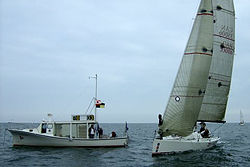Yacht racing
 Yacht racing is the sport of co
Yacht racing is the sport of co
Harbour or buoy racing
Harbour or buoy races are conducted in protected waters, and are quite short, usually taking anyw
Offshore racingcircumnavigation of the world. Some of the most famous offshore races are the Sydney to Hobart Yacht Race, the Transpacific Yacht Race, the Fastnet race, the Bermuda Race, the 2005 Rolex Transatlantic Challenge and the West Marine Pacific Cup. Several fully-crewed round-the-world races are held, including the Volvo Ocean Race (formerly called the Whitbread Round the World Race), the Global Challenge and the Clipper Round the World Race. South African yacht clubs organise the South Atlantic Race (the former Cape to Rio race), the Governor's Cup from Cape Town to St. Helena Island, and a race between Durban and Mauritius. Single-handed ocean yacht racing began with the race across the Atlantic Ocean by William Albert Andrews and Josiah W. Lawlor in 1891; however, the first regular single-handed ocean race was the Single-Handed Trans-Atlantic Race, first held in 1960. The first round-the-world yacht race was the Sunday Times Golden Globe Race of 1968-1969, which was also a single-handed race; this inspired the present-day VELUX 5 Oceans Race (formerly the BOC Challenge / Around Alone) and the Vendée Globe. Single-handed racing has seen a great boom in popularity in recent years. There is some controversy about the legality of sailing single-handed over long distances, as the navigation rules require "that every vessel shall at all times maintain a proper lookout..."; single-handed sailors can only keep a sporadic lookout, due to the need to sleep, tend to navigation, etc.[1] Other races Certain races do not fit in the above categories. One such is the Three peaks yacht race in the UK which is a team competition involving sailing, cycling and running. Yacht Clubs Many town yacht clubs hold their own racing teams for both juniors and adults. The junior devisions are usually held under US Sailing's Junior Racing. Popular multi yacht club events are held by US Sailing that can sometimes include more than 100 entered boats per race making up the regatta. Junior sailing usually consists of optimist, 420 and laser boats that are broken down further depending on skill and age levels. Age levels are usually from either 8-18 or 8-20/21 years old.
Classes and ratings
Many design factors have a large impact on the speed at which a boat can complete a course, including the size of a boat's
sails, its length, and the weight and shape of its hull. Because of these differences, it can be difficult to compare the skills of the sailors in a race if they are sailing very different boats. For most forms of yacht racing, one of two solutions to this problem are used; either all boats are required to be identical (a one-design class), or a handicapping system is used. Other approaches include use of "open" classes or construction classes. In one-design racing all boats must conform to the same standard, the class rules, thus emphasizing the skill of the skipper and crew rather than having the results depend on equipment superiority. Examples of popular classes include Flying Scot, Etchells, Snipe, Star, Soling, Thistle, Lightning, Laser, and J/24. Each class has a detailed set of specifications that must be met for the boat to be considered a member of that class. Some classes (e.g.the Laser) have very tight specifications ensuring that there is virtually no difference between the boats (except for age) - these classes are sometimes called strict one-design. Other classes allow more variation, such as allowing both wood & fiberglass hulls (e.g. the Albacore) or other changes that do not give a theoretical advantage. At important regattas the boats are measured prior to the event to ensure that they do conform. An open class is based on a box rule, which specifies a maximum overall size for boats in the class, as well as features such as stability. Competitors in these classes are then free to enter their own boat designs, as long as they do not exceed the box rule. No handicap is then applied. Since it is essentially based on the use of custom boats, such events are generally limited to high-budget racers. Popular examples of open classes are the Open 50 and 60 classes used in single-handed offshore events. However the Moth class is an exception, with boats being no longer than 11 feet. A construction class is based around a formula or set of restrictions which the boat's measurements must fit to be accepted to the class. Resulting boats are all unique, yet (ideally) relatively close in size, cost and performance. America's Cup is the most famous competition involving construction class boats. Perhaps the most popular and enduring construction formula is The Metre Rule, around which several still popular classes were designed. When all the yachts in a race are not members of the same class, then a handicap is used to adjust the times of boats. The handicap attempts to specify a "normal" speed for each boat, usually based either on measurements taken of the boat, or on the past record of that kind of boat. Each boat is timed over the specified course. After it has finished, the handicap is added to each boat's finishing time. The results are based on this sum. Popular handicapping systems in 2006 include PHRF, portsmouth yardstick, IRC (Sailing), and ORR. Earlier popular rating systems include IOR and IMS



